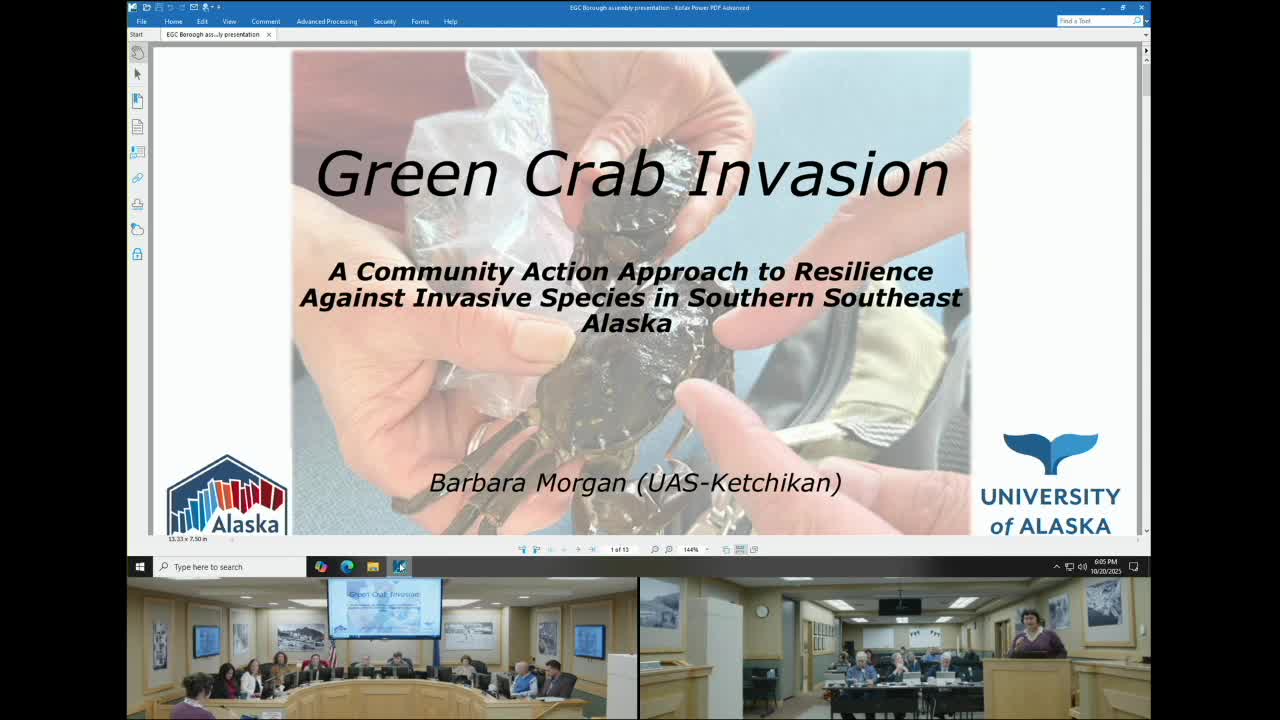Scientists warn of spreading European green crab in Ketchikan; public permitted response required
October 20, 2025 | Ketchikan Gateway Borough, Alaska
This article was created by AI summarizing key points discussed. AI makes mistakes, so for full details and context, please refer to the video of the full meeting. Please report any errors so we can fix them. Report an error »

Good evening. My name is Barbara Morgan, and I live at 192 Raspberry Lane. I am so happy that you invited me to talk about the European green crab situation, which has recently moved into the Ketchikan area.
Why it matters: University of Alaska Southeast instructor Barbara Morgan told the Ketchikan Gateway Borough Assembly that European green crab (Carcinus maenas) are aggressive, eat juvenile salmon and Dungeness crabs, tear up eelgrass habitat, and can reproduce rapidly. She said populations in Southeast Alaska have exploded from hundreds to tens of thousands in parts of the region this year, driven in part by warmer waters and larval transport up the coast.
What the borough heard: Morgan said the first confirmed shells in the Ketchikan area were located after a June community class. Live crabs and many shed shells have since been found around Annette Island, Gravina Island, Mud Bay and other local beaches; one recent survey reported more than 40,000 specimens collected in the region this year. She described the species’ biology (larvae free-floating up to three months, multiple spawnings annually) and explained why that makes eradication difficult once populations are established.
Permits and response: Morgan and borough staff explained that European green crab are a banned invasive species in Alaska and that possession and transport are regulated by Alaska Department of Fish and Game (ADF&G). She summarized three levels of permitting: molt-shell monitoring, educational handling, and an aquatic-resources permit required to kill or remove crabs. Morgan said the aquatic-resources permit is the appropriate pathway for neighborhood or organized eradication efforts and that ADF&G has provided guidance on permit applications and reporting.
Local coordination and next steps: Morgan outlined current local partners — Metlakatla Indian Community, UAS Ketchikan, Fish and Game and others — and urged coordinated “mass trapping” in priority estuaries (for example, Bostwick and Mud Bay) to keep populations down. She also noted research and mitigation lessons from Washington and Oregon, where green crab have damaged Dungeness crab and clam fisheries, and suggested the borough consider asking state or federal partners for guidance and funding.
Assembly reaction and follow-up: Multiple assembly members asked whether neighborhoods could obtain aquatic-resources permits to do trapping; Morgan said yes and encouraged organizers to coordinate with Fish and Game. The assembly asked staff to help draft a short briefing for the borough’s advocacy work and for possible state or federal funding requests.
Ending: The borough directed staff to follow up with ADF&G and local stakeholders on education, permitting pathways and possible targeted eradication pilot projects. Public education on identification (spines and bumps on the carapace) and how to report finds was emphasized as an immediate priority.
Why it matters: University of Alaska Southeast instructor Barbara Morgan told the Ketchikan Gateway Borough Assembly that European green crab (Carcinus maenas) are aggressive, eat juvenile salmon and Dungeness crabs, tear up eelgrass habitat, and can reproduce rapidly. She said populations in Southeast Alaska have exploded from hundreds to tens of thousands in parts of the region this year, driven in part by warmer waters and larval transport up the coast.
What the borough heard: Morgan said the first confirmed shells in the Ketchikan area were located after a June community class. Live crabs and many shed shells have since been found around Annette Island, Gravina Island, Mud Bay and other local beaches; one recent survey reported more than 40,000 specimens collected in the region this year. She described the species’ biology (larvae free-floating up to three months, multiple spawnings annually) and explained why that makes eradication difficult once populations are established.
Permits and response: Morgan and borough staff explained that European green crab are a banned invasive species in Alaska and that possession and transport are regulated by Alaska Department of Fish and Game (ADF&G). She summarized three levels of permitting: molt-shell monitoring, educational handling, and an aquatic-resources permit required to kill or remove crabs. Morgan said the aquatic-resources permit is the appropriate pathway for neighborhood or organized eradication efforts and that ADF&G has provided guidance on permit applications and reporting.
Local coordination and next steps: Morgan outlined current local partners — Metlakatla Indian Community, UAS Ketchikan, Fish and Game and others — and urged coordinated “mass trapping” in priority estuaries (for example, Bostwick and Mud Bay) to keep populations down. She also noted research and mitigation lessons from Washington and Oregon, where green crab have damaged Dungeness crab and clam fisheries, and suggested the borough consider asking state or federal partners for guidance and funding.
Assembly reaction and follow-up: Multiple assembly members asked whether neighborhoods could obtain aquatic-resources permits to do trapping; Morgan said yes and encouraged organizers to coordinate with Fish and Game. The assembly asked staff to help draft a short briefing for the borough’s advocacy work and for possible state or federal funding requests.
Ending: The borough directed staff to follow up with ADF&G and local stakeholders on education, permitting pathways and possible targeted eradication pilot projects. Public education on identification (spines and bumps on the carapace) and how to report finds was emphasized as an immediate priority.
View full meeting
This article is based on a recent meeting—watch the full video and explore the complete transcript for deeper insights into the discussion.
View full meeting
